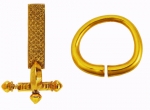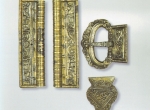Franks
Franks, the origins of the F. go back to the time of the formation of great tribes; during this early period together with Alamanni they raided the territory of the Roman Empire to west of the Rhine and plundered Gaul. Some F. served in the army of Imperium Galliarum,the usurper state of Postumus, as auxiliaries (auxiliis francicis). A group of F. tribes eventually settled in the area to the east of the Rhine, in its lower course (Salian F.), the other group (Ripuarian F. or Rhine F.) occupied the region of today’s Cologne.
F. farmers allowed to settle within the Empire as laeti had to serve in the Roman army. During the Late Roman Period they gradually became Romanized. As early as in the last quarter of the 4th century members of F. power elites rose to the office of magister militum (commander-in-chief of the Roman army), married into Roman senatorial families and adopted some elements of Roman military structures and strategy. F. military organization blended with the Roman and this system would survive until mid-5th century.
The presence of F. in the Roman army is evidenced by Germanic grave inventories discovered in Gaul containing Late Roman weapons and military belts. Metal elements such as chip-carved buckles and belt fittings are recorded both to the west and to the east of the Rhine. A typical F. weapon was the francisca – an axe used for throwing or in hand-to-hand combat.
The best known commander and at once king of the F. was Childeric († 482) from the Merovingian dynasty. His richly furnished tomb was discovered in 1653 in Tournai, Belgium. Among its furnishings were symbols of Childeric’s authority of Roman provenance – brooch type →Zwiebelknopffibel (crossbow brooch with onion shaped terminals) but also Germanic symbols of social prestige – a gold torse-like bracelet. The king was buried with many other fine quality ornaments, set with garnets or decorated with enamel (in cloisonné technique).
The extended sojourn of the F. in Gaul gave rise to a mixed community and to a Gallic-Germanic culture. The F. continued the tradition of Germanic kingdoms while remaining, at the same time, a part of the system of Late Antique states ruled by the army. On the threshold of the Middle Ages on what was officially still territory of the Roman Empire small kingdoms came into being.
Around the middle of the 5th century the Ripuarian F. emancipated themselves from under the Roman rule and took over the province of Germania II. In 468 all the other F. tribes led by Clovis defeated the Roman armies in Gallia Belgica II in the Battle of Soissons and cast off the yoke of the Gallo-Roman ruler Syagrius, son of Aegidius. Clovis also defeated other F. opponents and already in 509 the Ripuarian F. placed themselves under his dominion.
During a major battle with the Alamanni, in the fifteenth year of his reign, Clovis vowed that if victory was his he would have himself baptized. In this way, in 498 he officially embraced Christianity, and his 3000 subjects with him. The decision to adopt Christianity in the Roman Catholic rite was politically motivated as adoption of this religion helped to unify the Gallo-Roman population with the F. Later territorial conquests made by Clovis in Gaul became the basis for the formation of the medieval kingdom of the F.
JS
Literature: H. W. Böhme, Germanische Grabfunde des 4. bis 5. Jahrhunderts zwischen Elbe und Loire. Studien zur Chronologie und Bevölkerungsgeschichte, Münchner Beiträge zur Vor- und Frühgeschichte 19, München 1974; H. Ament, K. von Welck, A. Wieczorek (Eds.) Die Franken. Wegbereiter Europas. Vor 1500 Jahren: König Chlodwig und seine Erben. Katalog der Ausstellung im Reiss-Museum Mannheim 8. September 1996 bis 6. Januar 1997, Mainz 1996; H. W. Böhme, Aufstieg der Franken, Archäologie in Deutschland 1997/2, p. 30-35; G. Halsall, Childeric´s grave, Clovis´ succession and the origins of the Merovingian kingdom, [in:] R. W. Mathisen, D. Shanzer (Eds.), Society and Culture in Late Antique Gaul. Aldershot, Burlington VT 2001, p. 116-133; D. Geuenich, Germanen oder (Wahl-) Römer? Karrieren germanischer Offiziere ab dem 4. Jahrhundert n.Chr., [in:] St. Burmeister, H. Derks (Eds.), 2000 Jahre Varusschlacht. Konflikt, Stuttgart 2009, p. 253-257; G. Halsall, Die Militarisierung Nordgalliens. Föderaten und Föderatengräber, [in:] St. Burmeister, H. Derks (Eds.), 2000 Jahre Varusschlacht. Konflikt, Stuttgart 2009, p. 270-278; D. Quast, Das Grab des Frankenkönigs Childerich, [in:] St. Burmeister, H. Derks (Eds.), 2000 Jahre Varusschlacht. Konflikt, Stuttgart 2009, p. 379-381; M. Mączyńska, Światło z popiołu. Wędrwówki ludów w Europie w IV i V w., Warszawa 2013, p. 183-203.
-
 full resolution
full resolution
Fig. 1. Gold crossbow brooch (Zwiebelknopffibel) and gold torse-like bracelet from Childeric’s tomb (D. Quast 2009).
-
 full resolution
full resolution
Fig. 2. Military belt set from the Roman soldier's grave, Fallward, Kr. Cuxhaven. (M. D. Schön, Feddersen Wierde, Fallward, Flögeln, Bremerhaven 1999).


